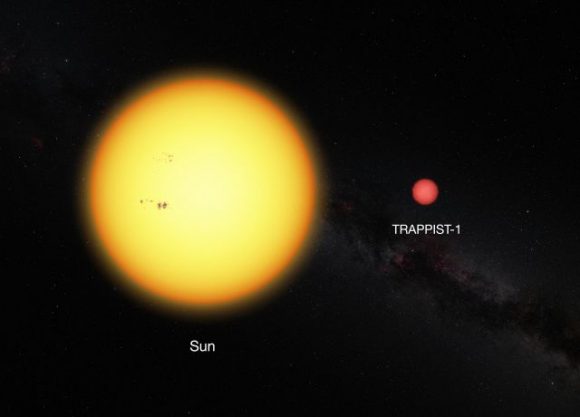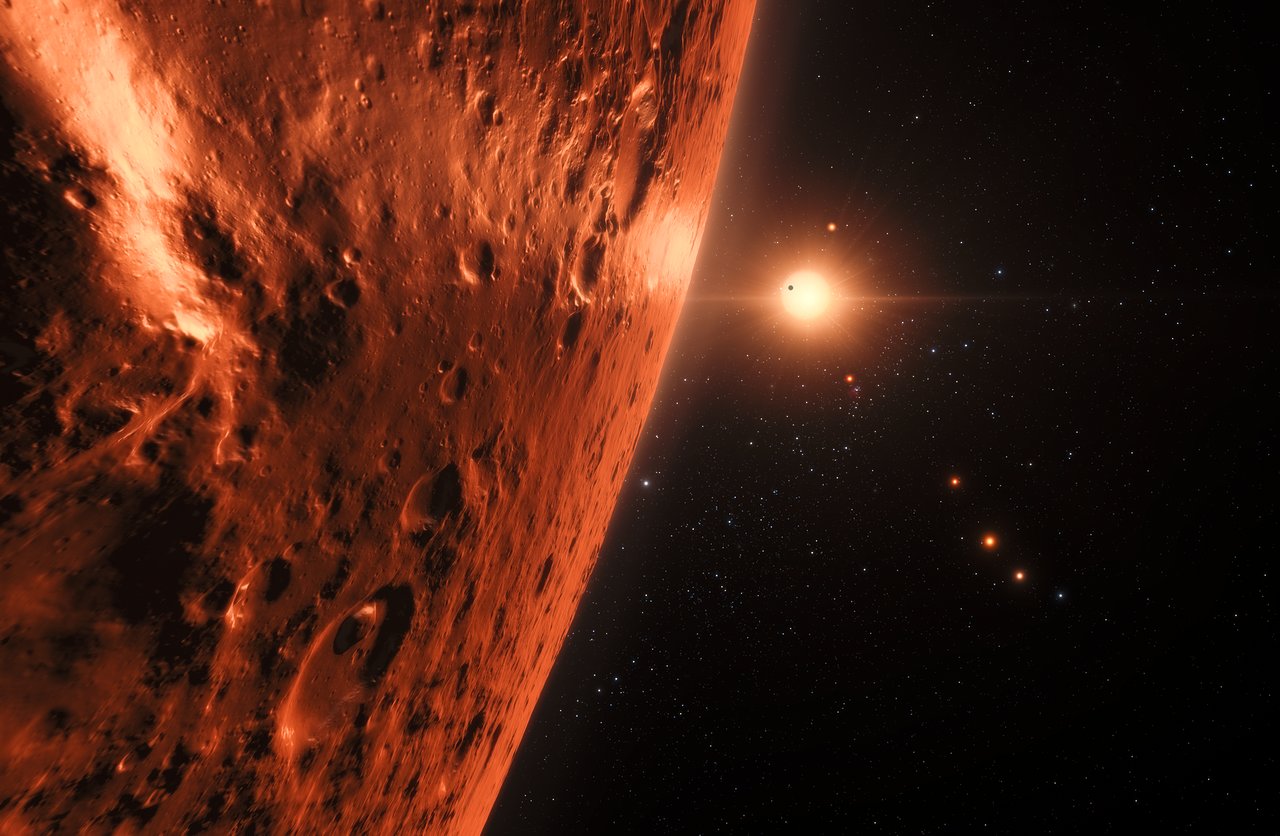In February of 2017, astronomers from the European Southern Observatory (ESO) announced the discovery of seven rocky planets around the nearby star of TRAPPIST-1. Not only was this the largest number of Earth-like planets discovered in a single star system to date, the news was also bolstered by the fact that three of these planets were found to orbit within the star’s habitable zone.
Since that time, multiple studies have been conducted to ascertain the likelihood that these planets are actually habitable. Thanks to an international team of scientists who used the Hubble Space Telescope to study the system’s planets, we now have the first clues as to whether or not water (a key ingredient
The team’s study, titled “Temporal Evolution of the High-Energy Irradiation and Water Content of TRAPPIST-1 Exoplanets“, recently appeared on the Hubble site. Led by Swiss astronomer Vincent Bourrier from the Observatoire de l’Université de Genève, the team relied on Hubble’s Space Telescope Imaging Spectrograph (STIS) to study the amount of ultraviolet radiation each of the TRAPPIST-1 planets receives.

As Bourrier explained in a Hubble press release, this helped them to determine the water content of the system’s seven planets:
“Ultraviolet radiation is an important factor in the atmospheric evolution of planets. As in our own atmosphere, where ultraviolet sunlight breaks molecules apart, ultraviolet starlight can break water vapor in the atmospheres of exoplanets into hydrogen and oxygen.”
How ultraviolet radiation interacts with a planet’s atmosphere is important when it comes to assessing the potential habitability of a planet. Whereas lower-energy UV radiation causes photodissociation, a process where water molecules break down into oxygen and hydrogen, extreme ultraviolet rays (XUV radiation) and x-rays cause the upper atmosphere of a planet to heat up – which causes the hydrogen and oxygen to escape.
Since hydrogen is lighter than oxygen, it is more easily lost to space where its spectra can be observed. This is precisely what Bourrier and his team did. By monitoring the TRAPPIST-1 planets spectra for signs of hydrogen loss, the team was effectively able to gauge their water content. What they found was that the UV radiation emitted by TRAPPIST-1 suggests that its planets could have lost quite a lot of water during their history.
The losses were most severe for the innermost planets – TRAPPIST-1b and 1c – which receive the most UV radiation from their star. In fact, the team estimates that these planets could have lost more than 20 Earth-oceans worth of water in the course of the system’s history – which is estimated to be between 5.4 and 9.8 billion years old. In other words, these inner planets would be bone dry and most definitely sterile.

However, these same findings also suggest that the outer planets of the system have lost significantly less water over time, which could mean that they still possess abundant amounts on their surfaces. This includes the three planets that are within the star’s habitable zone – TRAPPIST-1e, f and g – which indicates that these planets could be habitable after all.
These findings are bolstered by the calculated water loss and geophysical water release rates, which also favor the idea that the more-massive and outermost planets have retained most of their water over time. These findings are very significant, in that they further demonstrate that atmospheric escape and evolution are closely linked on the planets of the TRAPPIST-1 system.
The findings are also encouraging, since previous studies that considered atmospheric loss in this system painted a rather grim picture. These include those that indicated that TRAPPIST-1 experiences too much flare, that even calm red dwarfs subject their planets to intense radiation over time, and that the distance between TRAPPIST-1 and its respective planets would mean that solar wind would be deposited directly onto their atmospheres.
In other words, these studies cast doubt on whether or not stars that orbit M-type (red dwarf) stars would be able to retain their atmospheres over time – even if they had an Earth-like atmosphere and magnetosphere. Like Mars, this research indicated that atmospheric stripping caused by solar wind would inevitably render their surfaces cold, desiccated, and lifeless.

In short, this is one of the few pieces of good news we’ve received since the existence of seven planets in the TRAPPIST-1 system (and three potentially habitable ones) was first announced. It’s also a positive indication as far as the habitability of red dwarf star systems go. In recent years, many of those impressive exoplanet finds have taken place around red dwarf stars – i.e. Proxima b, LHS 1140b, Gliese 581g, Gliese 625b, and Gliese 682c.
Given the number of rocky planets that have been detected orbiting this type of star – and the fact that they are the most common in in the Universe (accounting for 70% of stars in the Milky Way alone) – knowing that they could support habitable planets is certainly welcome! But of course, Bourrier and his colleagues emphasize that the study is not conclusive, and further research is needed to determine if any of the TRAPPIST-1 planets are actually watery.
As Bourieer indicated, this will most likely involve next-generation telescopes:
“While our results suggest that the outer planets are the best candidates to search for water with the upcoming James Webb Space Telescope, they also highlight the need for theoretical studies and complementary observations at all wavelengths to determine the nature of the TRAPPIST-1 planets and their potential habitability.”
Rocky planets around the most common type of star, the potential to retain water, and 1oo billion potential planets in the Milky Way Galaxy alone. One thing is for sure: the James Webb Space Telescope is going to have its hands full once it is deployed in October of 2018!
And be sure to check out this animation of the TRAPPIST-1 system as well, courtesy of L. Calçada and the ESO:
Further Reading: Hubble Space Telescope, HST (2)

